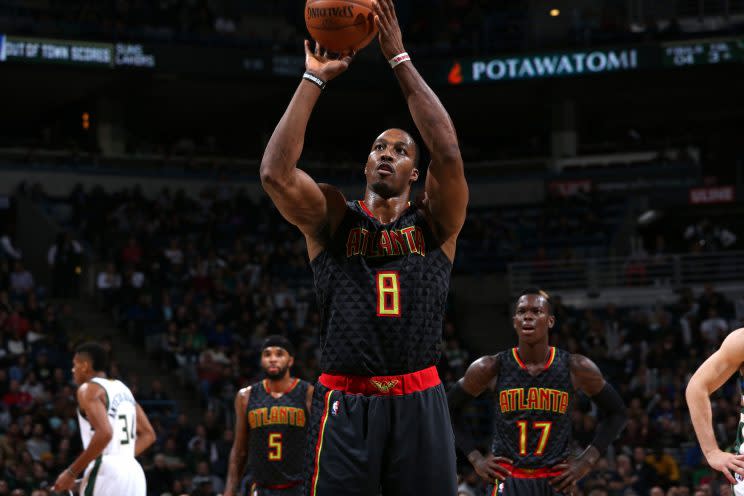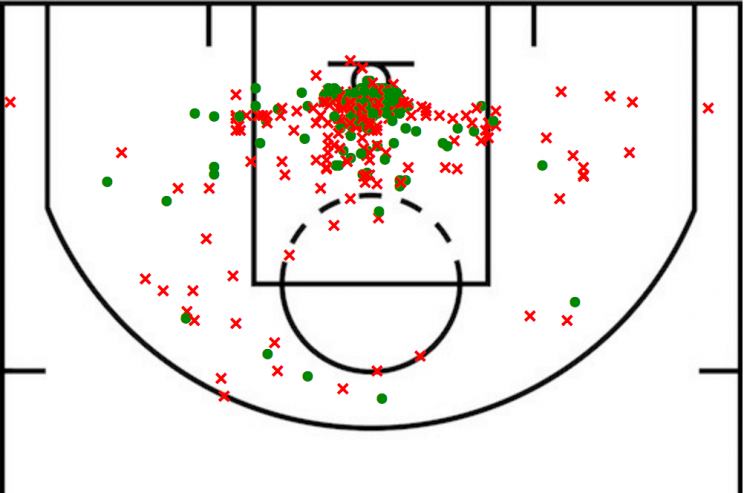Dwight Howard says he's going to become a 3-point shooter. He's probably wrong.

So Dwight Howard says he’s working on his 3-point shot. It’s not the first time he’s fantasized about a future as a stretch-five, nor is it likely to be the last time we’ll hear about his efforts to expand his game.
Here’s what Howard said on ESPN’s The Jump on Tuesday about his offseason plans for improvement:
Hawks center Dwight Howard says he's "working hard" on his 3-point game to extend career. He's 5-of-56 from 3-point range in his career. pic.twitter.com/FzJx9BOcsJ
— Jordan Heck (@JordanHeckFF) June 6, 2017
“I’ve been working on my 3s,” Howard said. “Really trying to add some range to my game. Which is gonna be weird for people to see, I guess, they’re used to seeing me in the paint, battling. But in order for me to play longer, I have to expand my game.”
It would be a massive addition to Howard’s game if he could add a 3-point jumper to his arsenal. The problem: The idea seems a bit far-fetched.
[Fantasy Football is open! Sign up now]
For one, Howard’s arsenal doesn’t even currently include a mid-range jumper. The former All-Star shot 22.8 percent on jump shots in 2016-17, per Basketball Reference, and made jumpers at a 24.3 percent clip over the past five seasons. Here’s his shot chart from last year, followed by his shot chart from 2012-13, the season within that five-year range during which he took the most jump shots:


It’s not like Howard is a high-volume, low-efficiency shooter, nor is he necessarily moving his game away from the basket. Per Basketball Reference, the average distance from the rim of Howard’s field goal attempts in 2016-17 was 2.9 feet, the third lowest of his career. The previous year’s average of 2.6 feet was the lowest. He doesn’t shoot many mid-range jumpers, and he doesn’t make many of the ones he takes.
Plenty of big men, both centers and power forwards, have added the 3-pointer to their game over the past five or six years after they were already established as more traditional post players. The difference between many of them and Howard: Those who have successfully stretched their games were already average or above average mid-range or free-throw shooters before the extension. Howard is neither.
Among the high-profile examples, DeMarcus Cousins was the most surprising. He was a high-volume (and likely high-difficulty) 32 percent jump shooter over the five seasons before he began stepping behind the arc regularly. But he is a career 73.6 percent free throw shooter, and free-throw shooting is generally a decent predictor for 3-point capabilities. Al Horford is 74.8 percent from the free-throw line for his career. Anthony Davis is 78.7 percent. Brook Lopez is 79.4 percent. Howard, on the other hand, is a career 56.6 percent shooter from the charity stripe.
Horford and Lopez were also both in the low 40s as jump shooters. Davis was high 30s. Howard’s low-20s number is a big red flag when it comes to his potential as a 3-point shooter. His first move should be to hone his mid-range game, enough so that a wide-open 18-footer becomes an efficient shot. At the moment, it’s not.
Howard was an NBA All-Star and still is an NBA starter because he’s 6-foot-11, well-built and super athletic for his size. He is not, however, in the NBA because of his deftness with a basketball in his hands. And he’s certainly not in the NBA because he can put a basketball through a hoop consistently from a distance greater than 10 feet.
Some players just aren’t built to consistently make shots from 23 feet. Howard, in all likelihood, is one of them. That’s not to say he can’t or shouldn’t try. But the odds are against him.


